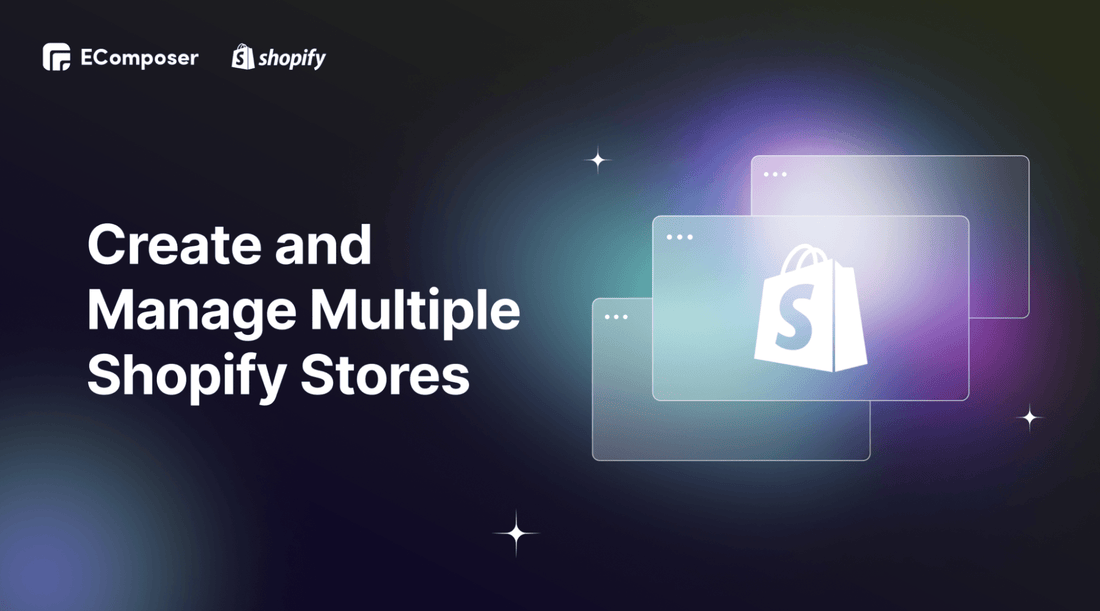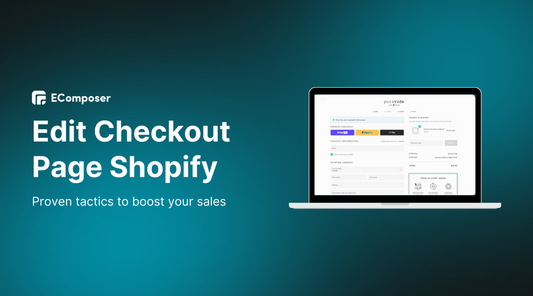How to Create & Manage Multiple Shopify Stores

Table Of Contents
Opening a Shopify store brings many great benefits to your business. However, managing multiple stores can become chaotic if you don't lay a solid foundation for management.
In this blog you can find How to create and manage multiple Shopify stores. Moreover, we also answer questions our customers often ask when they own multiple Shopify stores.
Before going into the details, make sure you have built an eCommerce store on Shopify!
Benefits of creating multiple Shopify stores

1 - Expand your business to the world
When you want to expand your business overseas, you have to take into account all the constraints, buying patterns, and behavioral patterns of those markets. It's easier to tailor your website and services to each country's target market if you have a separate Shopify store for each country.
Regional stores allow you to organize inventory in several locations, facilitate efficient logistics for sellers, and quick delivery to customers.
2 - Expand and develop business ideas
If you have a lot of business ideas but don't know how to execute them, opening a new store is a great idea.
Regardless of whether your store idea is relevant or not, you will need a separate store for each of your eCommerce projects. In fact, someone even opened up to 5 stores to develop 5 different business ideas. However, this means that you need to learn how to allocate more time and invest more brainpower.
[ecom-global-block]ecom-shopify-trial-block[/ecom-global-block]
3 - Open a small shop or an agency
Prior to entering new markets, you should focus on tailoring the purchasing experience for all of your clients. To do this, you could wish to launch many Shopify stores targeted at clients with various purchasing preferences.
Your segmented audiences may discover exactly what they want at the price they want with the aid of a general shop, a high-end boutique, and a discount outlet all operating under the same brand.
4 - Develop separate new product lines
Some retailers wish to create subsidiary brands or separate product lines under the same corporate umbrella. When releasing a product that appeals to a market outside of your typical customer base, this can be useful.
Create multiple stores under one Shopify account

To create a new store under one Shopify account, you need Store management access which is only available in Shopify Plus plan.
Follow the steps below:
Step 1: Create store
- From the Shopify organization admin, choose Stores, and click Create store.
- In the Store type section, select the purpose of your new store.
- In the Store details section, enter a name and an URL. The URL that you choose can't be changed.
Step 2: Set up store
- Select the purpose of the new store in the Store Type section, then enter the name and URL in the Store Details section
Note: Once saved, you cannot change the URL
Step 3: Import themes:
- In the Themes section, click Import subject.
- Check the topics you want to import.
- From the Choose a theme to publish in your new store listing list, select the theme you want to use for your store
- Click Done.
Step 4: Enter store staff
- In the Users section, click Import User.
- Check the employee you want to enter.
- Click Done.
Step 5: Complete the store creation process
- Click Create store
You can now log into the store and start adding details.
Create multiple stores using different Shopify accounts
If you do not have enough money to maintain the Shopify Plus plan, do not be discouraged because you can completely own multiple Shopify stores by creating another account.
Create a new account, build the store, and launch it as you did with your first store. Please understand that this is a brand-new store and you can build it completely independent of your previous store.
Refer to the basic steps to create a Shopify store
Creating a new store shouldn't cause any problems with your old store. You can completely run two stores side-by-side and choose the right third-party apps for each store.

We recommend using EComposer - Landing Page Builder to make the process of building and operating your Shopify store easier. With this app, you can build a professional store with all types of page such as a Landing Page; Product Page; Blog Post; Thank you page; Coming Soon Page; Gallery Page; etc. EComposer bring the best solutions for your Shopify stores from page building to optimize conversion rates.
Specifically, EComposer provides 200+ sections, 100+ page templates, 90+ elements, 50+ extensions and a lot of other advanced features. Moreover, you also can utilize AI Content Generator in EComposer to write content for your page smartly.
5 useful tips for managing multiple Shopify stores

1 - Leverage CRM
Online businesses simply cannot afford to let their clients down. For business owners, managing customer assistance for several locations may be difficult. The answer is to standardize customer service across all of the stores using a CRM. You may simplify the customer care process by integrating all of your Shopify stores with a single customer relationship management program. Quickly resolving customer questions and support requests may build confidence, enhance user experience, and eventually grow a devoted client base.
2 - Optimize each store
You must optimize your various storefronts to cater to that audience if you want to grow to other geographies, different demographics, or any other new market.
Your website's content, featured products, and offers should all be customized for your target market. You might try several offers to see which gets the most clicks in order to figure out what works. Alternately, you might do keyword research using particular geographic locations to discover the purchasing patterns of local customers.
3 - Implement real-time inventory updates
Consider using real-time inventory updates to correctly manage your inventory across numerous shops. As products are bought, restocked, and returned, your inventory levels should alter fairly instantaneously. Real-time inventory updates aid in efficient logistics and fulfillment, help to avoid overselling, and safeguard the customer experience.
4 - Synchronize orders and inventory
Invest in a central hub that can synchronize orders and inventory across all sales channels and fulfillment partners if you operate with more than one warehouse or several 3PLs.
A unified order management system can ease the effort of fulfilling and keeping track of all the orders that pass through your locations.
5 - Use third-party apps to manage multiple Shopify store
On Shopify, there are many applications that help you easily manage multiple stores effectively. Through information synchronization between stores, improved customer service, and many other features, the applications simplify management.
By using such applications, you may greatly increase business productivity and simplify the process. Three Shopify apps that make managing multiple stores simple are covered here.
Matrixify

When working with your store data in bulk, save time and anxiety. Matrixify can manage file volumes up to 10 GB for both small businesses and big corporations. Through Google Sheets, FTP servers, Excel, and other data formats and methods, easy data changes, reports, and automations are all possible.
langify

Sell to new clients by providing them with your products in their own language by using langify. To achieve the best results, automatically translate and manually correct. For combining or saving, export and import your work. Provide local money and speak to your consumers personally. with several Third-Party App connections, as well as individual client-specific solutions.
Syncio Multi Store Sync

Use Syncio Multi Store Sync to quickly import and sync goods with up-to-date inventory. Sync product fields like pricing, tags, descriptions, and picture files. Automate orders by having Syncio push them and update tracking and fulfillment. Syncio also supports multiple inventory locations, allowing you to choose a certain place to deliver merchandise to.
Frequently Asked Questions About Shopify Multiple Stores
1 - Can I create multiple stores on one Shopify account?
Yes!
As mentioned above Shopify allows customers to open multiple stores on one account when customers use Shopify Plus plan. Shopify Plus is specifically for large businesses with extreme traffic, which the vast majority of store owners don't have.
Shopify Plus provides an infinite number of stores if you have $2,000 per month to invest on your eCommerce solution and are a very large company. Your subscription includes 10 stores, however an extra store costs $250 per month.
2 - How Much Does it Cost to Create Multiple Shopify Stores?
With Shopify Plus, you may open up to 10 stores in addition to your primary one. Your platform cost, which begins at $2,000, includes them all. You must pay $250 for any retailer that exceeds that cap. However, the price of each new store for ordinary Shopify customers will depend on the plan you select for it:
- Basic: $29/month
- Shopify: $79/month
- Advanced: $299/month
Let’s say your main store uses an Advanced plan, and you want to create a second store that uses the Basic plan.
Your cost for both stores would amount to $328 a month.
3 - Can I Have Multiple Shopify Stores?
You can completely own multiple stores by creating multiple accounts. This helps you not to spend a large amount of money to use Shopify Plus plan.
4 - Can I Use More Than One Domain For My Shopify Store?
Shopify only allows one primary domain. However, if you use Shopify Plus, you can have up to 10 domains or subdomains for your Shopify store.
For Shopify Plus plan, customers can use up to 1000 domains or subdomains.
[ecom-global-block]ecom-shopify-commerce-coach-block[/ecom-global-block]
Wrap up
Creating multiple Shopify stores only benefits your business when applied correctly. I hope this blog gives you the right direction in creating and managing multiple Shopify stores.
If you want more information or want to learn more about EComposer, follow us at ecomposer.io or click on the message icon located in the right corner of the screen.
=================
Add EComposer Next generation page builder Here
Follow Us on Facebook
Join Official Community





















0 comments